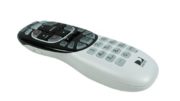Even if you’re just a regular TV viewer, you probably noticed that the connectors on your cables don’t look like they used to. There was a time that video cables had a hexagonal connection between the black outer insulating layer and the connector itself. The old style is referred to as a hex crimp, or crimp-on connector. The connector starts out round and is attached to the cable by applying pressure until the edges flatten out. Crimp-on connectors were the standard for cable and satellite until the mid-1990s when they were replaced with the new style, called compression connectors.
The right tool for the job
Compression connectors use a special tool that pushes the bottom of the connector up into the middle part, creating a tighter seal. Compression connectors are the standard for all digital cable and satellite installations, and we advise that all connections in your home theatre use these compression connectors.
But why?
In our Cable Comparison Shootout, we showed that a decades-old cable with a hex crimp could perform just as well as a newer one, but that’s not always the case. Hex crimp cables have three critical flaws that can make a cable fail over time:
- The crimp is likely to loosen over time, letting water in and ruining the connection.
- Because the pressure on the cable itself isn’t the same all the way around, the outer shield is more easily broken.
- It’s harder to make a good crimp-on cable so there are more poor quality ones out there.
On the other hand, making a good cable with compression connectors is easier. Compression connectors protect the metal shielding that is an essential part of a coaxial cable. Today’s cable and satellite systems carry much, much more data than older systems so it is important that cables be in tip-top shape.
While we’re on the subject, you should also avoid plastic molded cables, because they are far more prone to quality control issues as well.
Which compression tool and connector should you use?
Honestly, it doesn’t make as much difference as you think. As long as you are using high-quality connectors and a good quality tool, you’ll be fine. The tool is going to be a very personal choice. I prefer one with a good racheting action but others prefer something compact that feels better in the hand. As long as you’re spending over about $30 you’re going to get a good quality tool.
Your choice of connectors often boils down to two. A lot of professionals prefer the Belden Snap-N-Seal because it’s durable and reliable. DIRECTV DIYers prefer the Perfect Vision RidgeLoc which is specifically DIRECTV approved and can be a little less expensive. I’ve also had good experience with the Digicon shown above which seems to be reasonably reliable and easy to work with. If you do a lot of this kind of thing, you should check with the companies you work with. See what they prefer, and use that. If you’re just making an occasional cable, most compression connectors will work with most cables.
Get all the accessories you need at Solid Signal, not at a home store
Like you, I’ll shop at a big-box home store when I need something. The prices are low and the selection is good. But, when it comes to cables, they often offer inferior products that look good. The consumer usually can’t tell the difference between these and the ones that real professionals use. But trust me, the last thing you want is a flaky cable. This sort of problem is often extremely difficult to diagnose and will eat up a lot of time.
Just don’t go there. Instead, shop at Solid Signal for pro-quality compression connectors and tools.




